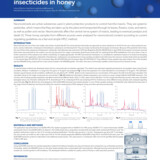
Neonicotinoids are active substances used in plant protection products to control harmful insects. They are systemic pesticides, which means that they are taken up by the plant and transported through its leaves, flowers, roots, and stems, as well as pollen and nectar. Neonicotinoids affect the central nerve system of insects, leading to eventual paralysis and death [1]. Three honey samples from different sources were analysed for neonicotinoid content according to current regulating guidelines via a fast and simple HPLC method.

Chromatogram of mixed standard at 10 μg/mL, 1) thiamethoxam, 2) clothianidin, 3) imidacloprid, 4) acetamiprid

Overlay of standard at 2.50 μg/mL (blue) and cleaned sample of fruit blossom honey (red), Zoom in

Overlay of standard at 2.50 μg/mL (blue) and cleaned sample of KNAUER honey (red)

Overlay of standard at 2.50 μg/mL (blue) and cleaned sample of canola honey (red)
| Methode | HPLC |
|---|---|
| Modus | RP |
| Substanzen | Thiamethoxam, clothianidin, imidacloprid, acetamiprid |
| Schlüsselwörter | Insecticides, pesticides, neonicotinoids, honey, QuEChERS, neuro-active insecticides, bee losses, dispersive SPE |
| CAS Nummer | 153719-23-4, 210880-92-5, 138261-41-3, 135410-20-7 |

Wir helfen Ihnen gerne!